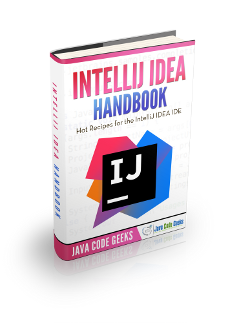IntelliJ IDEA Tutorials
In this detailed Resource page, we feature an abundance of Intellij IDEA Tutorials!
IntelliJ IDEA is a Java integrated development environment (IDE) for developing computer software. It is developed by JetBrains (formerly known as IntelliJ), and is available as an Apache 2 Licensed community edition, and in a proprietary commercial edition. Both can be used for commercial development.
History
The first version of IntelliJ IDEA was released in January 2001, and was one of the first available Java IDEs with advanced code navigation and code refactoring capabilities integrated.
In a 2010 Infoworld report, IntelliJ received the highest test center score out of the four top Java programming tools: Eclipse, IntelliJ IDEA, NetBeans and JDeveloper.
In December 2014, Google announced version 1.0 of Android Studio, an open-source IDE for Android apps, based on the open source community edition of IntelliJ IDEA. Other development environments based on IntelliJ’s framework include AppCode, CLion, PhpStorm, PyCharm, RubyMine, WebStorm, and MPS.
Features
Coding assistance
The IDE provides certain features like code completion by analyzing the context, code navigation which allows jumping to a class or declaration in the code directly, code refactoring and options to fix inconsistencies via suggestions.
Built in tools and integration
The IDE provides integration with build/packaging tools like grunt, bower, gradle, and SBT. It supports version control systems like Git, Mercurial, Perforce, and SVN. Databases like Microsoft SQL Server, ORACLE, PostgreSQL, and MySQL can be accessed directly from the IDE.
Plugin ecosystem
IntelliJ supports plugins through which one can add additional functionality to the IDE. Plugins can be downloaded and installed either from IntelliJ’s plugin repository website or through the IDE’s inbuilt plugin search and install feature. Currently, IntelliJ IDEA Community edition has 1495 plugins available, while the Ultimate edition has 1626. These figures are much smaller than those of editors such as Atom, which has over 7000 packages (essentially plugins). However, some features that are included by default in IntelliJ can only be added to Atom by installing packages. For example, linting is built into IntelliJ, and it can be installed in Atom, per programming language, with a variety of packages.
If you wish to build up your Intellij IDEA knowledge first, check out our IntelliJ IDEA Tutorial for Beginners.
Intellij IDEA Tutorials – Getting Started
Simple examples based on Intellij IDEA
- IntelliJ IDEA Automatic Deploy Example
In this example we demonstrate how you can turn on the automatic deployment for your web project in IntelliJ IDEA. This feature is especially useful while developing HTML, JSP, JavaScript, CSS and image files. - IntelliJ IDEA Remove Project Example
In this example we demonstrate an IntelliJ IDEA Remove Project Example. Unlike many other powerful features of this IDE, it is not intuitive but by using the above steps, you will be able to achieve it quite easily. - IntelliJ IDEA Debug Java Application Example
In this example we demonstrate how you can leverage the power of debugging tools of IntelliJ IDEA. It’s a famous saying that “Necessity is the mother of invention”. - IntelliJ IDEA Code Review Example
In this post we feature a comprehensive Example on IntelliJ IDEA Code Review. We will learn how we can use IDEA IntelliJ for code reviews. - IntelliJ IDEA Show File in Project View Example
In this article we will learn about Project View of IDEA IntelliJ and how to access it and what are the shortcuts which we can use. - IntelliJ IDEA Project Structure Example
In this example we will learn about IntelliJ project structure. IntelliJ is one of the most commonly used IDE by Java developers. For this example we will use 2017.2.2 version of IntelliJ. - IntelliJ IDEA Run with Coverage Example
In this article we will see how we can run a test with coverage using IDEA IntelliJ. - How to Install IntelliJ IDEA on Ubuntu Linux
This tutorial has shown you how to download and install IntelliJ IDEA Java IDE on Linux systems. We have seen how to install it step by step, understanding the meaning and implications of each one. To end up, we have seen a list of other JCG posts to dive into IntelliJ IDEA, once successfully installed. - IntelliJ IDEA Format Code Example
This tutorial has shown how works the IntelliJ IDEA code formatter, seeing how we can format our code with a simple shortcut, and also customizing the code style to apply in a very complete way, from white spaces and line wrappings, to JavaDoc and code arrangement. - IntelliJ IDEA Create Test Tutorial
This tutorial will show how to create tests for our Java projects with IntelliJ IDEA. We have seen two ways, manually and automatically, being the second one the most comfortable for almost every cases. - IntelliJ IDEA Keyboard Shortcuts Tutorial
In this tutorial we are going to see the IntelliJ IDEA shortcuts for code edition, navigation between files and compilation and execution of the project. - Top 10 IntelliJ Idea Plugins
In this article we are going to present the 10 most useful to our point of view plugins for any developer using this IDE. - IntelliJ Increase Memory Settings
In this article we are going to provide some guidelines on how to increase memory heap on IntelliJ IDEA and on how to configure the VM options. For our example we are using IntelliJ IDEA Community Edition version 14.1.2. - Eclipse Gradle Plugin Example
In this example we will see how to use Gradle as a plugin through our favorite Eclipse IDE. - IntelliJ Idea Color Schemes / Themes Configuration
In this article we are going to present how to customize the IntelliJ IDEA built-in color schemes or provide your own color theme for use in the IDE. - IntelliJ GUI Designer Example
This example demonstrates how you can utilize IntelliJ GUI Designer to create a graphical user interface that is based on the Swing library components.
[undereg]


